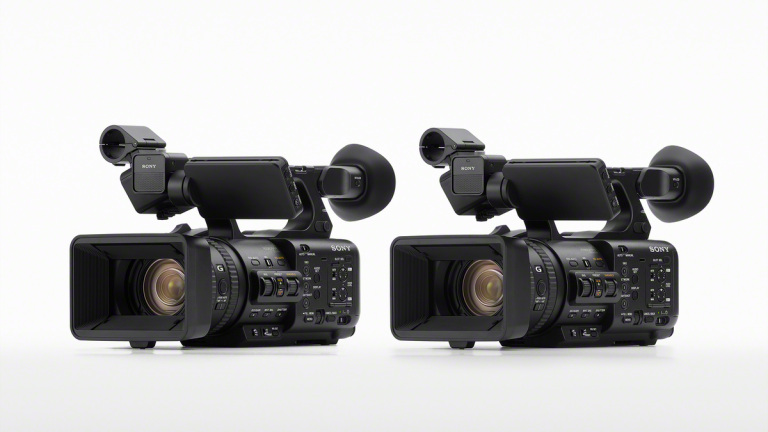What to Know about Sony's New 4K Handheld Professional Camcorders
New cameras designed with AI-based subject recognition autofocus, tracking, and auto framing.

Broadcast continues to merge its way into the Pro AV universe and Sony Electronics is meeting those demands with its two new 4K handheld camcorders. Meet the NXCAM HXR-NX800, and XDCAM PXW-Z200 designed for individuals and small teams supporting applications within broadcast, corporate, faith, and education. Both were crafted with SDI and MXF wrapper and feature artificial intelligence (AI) recognition capabilities, high-precision autofocus (AF), a 20x optical zoom lens, a variable neutral-density (ND) filter, and assignable lens ring. The new models combine portability, functionality, interoperability, and network connectivity for a high-quality and inclusive capture and live streaming experience.
AI subject recognition, auto focus (AF), and support for 4K 60p/120p recording facilitate high-quality capture with less manual input. The cameras feature a BIONZ XR image processing engine and a specialized AI-processing unit for highly accurate, real-time recognition, tracking, and framing of subjects. In addition, the HXR-NX800 and PXW-Z200’s 1.0-inch-type Exmor RS CMOS stacked sensor provides high-sensitivity and low-noise capability.
[Nearly 100 Sony Cameras to Power 2024 Paris Olympics]
An Electronic Variable ND Filter enables users to toggle seamlessly between 1/4 to 1/128 density. Users also have the option to enable auto-ND, which allows the camera to maintain an optimized exposure without the user having to adjust settings—especially useful when moving quickly between indoor and outdoor environments. Two rings for focus and zoom and two dials for IRIS/ND Variable are located side-by-side, for effortlessly adjusting exposure along with focus and zoom. Twelve assignable buttons provide further customization.
The two new cameras are equipped with Sony’s G Lens with a 20x optical power zoom that covers 24mm wide angle to 480mm telephoto and a maximum aperture of F2.8-F4.5. The models can achieve 30x (4K) and 40x (HD) zoom using Sony’s Clear Image Zoom technology.
Active mode combines electronic correction with optical image stabilization to provide smoother imagery on the go.
Both cameras feature a newly designed foldable viewfinder, a removable microphone holder, and a foldable 3.5-inch LCD monitor that allows users to check images and focus in bright environments. The new models are compact and have an exceptionally lightweight body for their rich feature set. Additionally, either model can be folded up for further ease of storage and portability.
A daily selection of features, industry news, and analysis for AV/IT professionals. Sign up below.
[4 Topics Trending in Pro AV this Summer]
The HXR-NX800 and PXW-Z200 provide beneficial integration with Sony’s camera portfolio. Presets such as S-Cinetone, ITU709, 709tone, HLG Live, HLG Mild and HLG Natural, can be easily adjusted to color match the footage captured on Sony’s other broadcast, Cinema Line, and AlphaT cameras.
Additionally, the HXR-NX800 and PXW-Z200 are equipped with various interfaces including HDMI Type A, USB Type-C, LAN, and REMOTE terminals. The PXW-Z200 supports SDI (12G, 6G, 3G [Level A/B], HD) output, and TC input/output.
The HXR-NX800 and PXW-Z200 offer an all-in-one recording and streaming solution that empowers a single operator or small team to easily manage both capture and distribution. Connecting the cameras to a network, such as Wi-Fi, enables live streaming of recorded footage to streaming services and video sites via RTMP/RTMPS or SRT.
Furthermore, by combining it with Sony’s new portable data transmitter, PDT-FP1, the two new camcorders can support higher quality streaming with the company’s proprietary QoS technology and Creators’ Cloud for enterprise services, including the camera linking cloud service, C3 Portal (paid service), XDCAM pocket, and the cloud broadcast system, M2 Live.
The new camera bodies feature resin which incorporates SORPLAS, a flame-retardant recycled plastic that is made from up to 99% recycled material. Over the past 12 years, Sony has replaced approximately 426 tons of virgin plastic in digital cameras and camcorders with recycled plastic. The packaging of the HXR-NX800 and PXW-Z200 further reflects Sony’s efforts to minimize the use of plastic.
The AVNetwork staff are storytellers focused on the professional audiovisual and technology industry. Their mission is to keep readers up-to-date on the latest AV/IT industry and product news, emerging trends, and inspiring installations.
